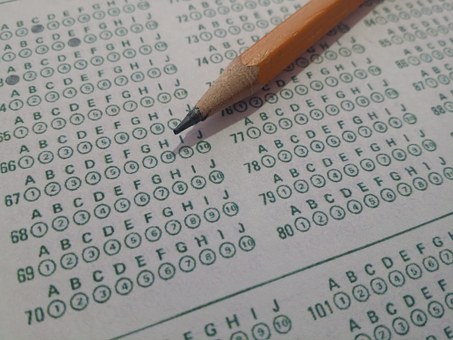
by Erica L. Meltzer | Sep 13, 2019 | ACT English/SAT Writing
Dashes are a form of punctuation that is pretty much guaranteed to show up on both the ACT® English Test and the multiple-choice SAT® Writing Test. Because they tend to be used more frequently in British than in American English, they are typically the least familiar type of punctuation for many students. That said, they are relatively straightforward.
Dashes are tested in three ways. The first is extremely common, the second less common, and the third rare.
1) To set off a non-essential clause (2 Dashes = 2 Commas)
In this case, dashes are used exactly like commas to indicate non-essential information that can be removed without affecting the basic meaning of a sentence. If you have one dash, you need the other dash. It cannot be omitted or replaced by a comma or by any other punctuation mark. This is the most important rule regarding dashes that you need to know.
Incorrect: John Locke–whose writings strongly influenced The Declaration of Independence, was one of the most important thinkers of the eighteenth century. (more…)

by Erica L. Meltzer | Sep 23, 2017 | Blog
The ACT has recently made a somewhat under-reported change to its accommodation policies.
In the past, students with extra time who took the non-Writing version were given 5 hours to complete all four multiple-choice sections, whereas students who took the Writing version were given 6 hours for the four multiple-choice sections plus the Essay.
Although students could not move back and forth between sections, they could divide up the time in any way they wanted — so if they wanted to spend an extra 10 minutes on Reading, for example, they could potentially “borrow” that time from the less important Essay. For a slow reader with good comprehension, those 10 minutes could easily make a difference of two or three points.
Students not taking the Writing version could still divide their 5 hours as they wanted; however, they did not have the option of borrowing against the Essay, putting them at a potentially significant disadvantage. (more…)
by Erica L. Meltzer | Sep 1, 2013 | ACT English/SAT Writing
I think it’s fair to say that the ACT really, really likes to test commas. I’ve never done a statistical analysis, but I’d wager that it’s around 15-20%.
But while the ACT does test commas in many different ways, the reality is that you don’t have to know every last rule governing comma usage. As long as you know the major ways in which commas are used correctly, you can probably identify when a comma is not being used correctly.
So that said, here are the contexts tested on the ACT that require you to absolutely, conclusively use a comma:
1) Before a FANBOYS (coordinating) conjunction when joining two independent clauses
Example: London is a very old city, and it contains buildings from many different eras.
2) To set off a non-essential clause that can be removed from a sentence
Example: London, which is a very old city, contains buildings from many different eras.
3) Between items in a list
Example: London contains buildings from time periods including the Middle Ages, the Renaissance, and the Victorian era. The third comma is optional, by the way. Since the sentence is correct both with and without it, you’ll never be tested on that particular usage.
4) To separate multiple adjectives whose order could be reversed
Example: London contains many interesting, eclectic neighborhoods, OR London contains many eclectic, interesting neighborhoods.
When you see a comma, ask yourself whether it’s being used in one of the above ways. If it isn’t, you can be relatively certain that you should choose an answer that doesn’t include it.
by Erica L. Meltzer | Aug 1, 2013 | ACT English/SAT Writing
The SAT and ACT do test a version of the “who vs. whom” rule, but only at a relatively superficial level. There are only two things you need to know:
1) Whom should not come before a verb
2) Whom should come after a preposition
For example:
Many people are familiar with the story of how the Pilgrim settlers met a Pawtuxet
tribe member named Squanto whom befriended them, taught them how to survive in
their new wilderness home, showed them how to plant crops, and acted as an interpreter
with the Wampanoag tribe and its chief, Massasoit.
A. NO CHANGE
B. which befriended
C. who befriended
D. and befriending
Yes, “who vs. whom” is clearly being tested here, but there’s a decent chance that you can hear that whom befriended sounds extremely awkward, and that who befriended sounds a lot better.
In grammatical terms, the simplest version of the rule here is that whom should never be used right before a verb. (Befriend is a verb because you can say to befriend). That’s it. In order to apply the rule, you do need to be able to accurately recognize verbs, but if you can do that, you’re pretty much set.
Now, here’s part two of what you’re likely to see.
Many people are familiar with the story of how the Pilgrim settlers met Squanto, a
Pawtuxet tribe member from whom they learned about planting crops and surviving
in the New World.
A. NO CHANGE
B. from who
C. by which
D. from which
There are two straightforward rules being tested here:
1) Who and whom = people; which = thing
2) Whom, not who, must follow a preposition
Therefore:
C and D can be easily eliminated because which should only refer to things.
B is incorrect because from is a preposition, and prepositions should be followed by whom, not who.
That leaves A, which correctly uses whom.
Generally speaking, the SAT and ACT are a lot more interested in testing whether people know the basics of correct English and are able to recognize flagrant mistakes than with how well they know complex grammar rules.
That means you’re exceedingly unlikely to see a question that looks like this:
Many people are familiar with the story of how the Pilgrim settlers met Squanto, a
Pawtuxet tribe member who they encountered shortly after arriving in the New World.
A. NO CHANGE
B. whom they encountered
C. which they encountered
D. they encountered him
To answer this question, you need to be able to recognize that the correct answer is the direct object of the verb encounter – that is, you would say encounter him (object pronoun), not encounter he (subject pronoun).
Whom is correct because it is an object pronoun, whereas who is a subject pronoun. Only an object pronoun can replace an object pronoun (him —-> whom).
But again, the chance of your encountering a question that tests the rule at this level of subtlety is so small that it’s not even really worth worrying about.
by Erica L. Meltzer | Jun 7, 2013 | ACT English/SAT Writing, Blog
When a lot of students start studying for ACT English/SAT Writing, one of the first things they often wonder is whether they actually really need to read the entire passage, or whether it’s ok to just skip from question to question.
My answer?
A resounding yes and no. That is, yes, they have to read everything, no they can’t just skip from question to question.
Here’s why:
ACT English and SAT multiple-choice Writing are context-based tests. Sometimes you’ll be asked about grammar, and sometimes you’ll be asked about content and structure. Both kinds of questions are often dependent on the surrounding sentence, however. A question testing verb tense may have four answers that are acceptable in isolation but only one answer that’s correct in context. If you don’t look at the surrounding sentences and see that they’re in the past, you might not realize that the verb in question has to be in the past as well.
Furthermore, it’s often impossible to answer rhetoric questions without a general knowledge of the paragraph or passage. If you’ve been reading the passage all along, you’re a lot more likely to be able to spot answers immediately since you’ll be able to tell whether a given choice is or is not consistent with the passage. If, on the other hand, you suddenly start reading surrounding sentences, you’re more likely to miss important information because you don’t have the full context for them.

